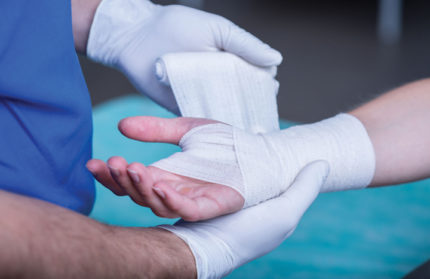FOOSH
It’s the second most common sports injury, but a fall onto an outstretched hand (FOOSH) can happen at any age.
A fall onto an outstretched hand is a common event in any age group—so common it has its own acronym, FOOSH. The cause of the fall can run the gamut: a sports injury, slip on ice, trip on an uneven surface, or simple loss of balance. Common among athletes—runners, skiers, skateboarders, pole vaulters—the injury can also occur in car accidents and whenever you try to break a fall by reaching out with your hand.
There’s a wide range of potential injuries to the hand, wrist, elbow or shoulder associated with this type of fall. Many of these injuries are minor, causing only temporary discomfort and requiring no special treatment. Some injuries are clearly more significant resulting in a broken bone or worse. But there’s a large middle ground, and it can be difficult to determine the significance of an injury.
In all ages, falls onto the hand most commonly cause wrist injuries. Elbow injuries and shoulder injuries may also occur, particularly in older age groups. Initial treatment almost always includes ice and relative immobilization—the rest and ice part of RICE.
When there’s an obvious injury—significant swelling, bone out of alignment—or the discomfort continues for a substantial time, you should seek medical attention.
The Wrist
Of the over 300 joints in the body, your wrist is one of the most complex structures, capable of moving in many directions. The two large bones in the forearm (the radius and ulna) join with eight smaller bones (the carpal bones). Most of the up and down motion of the wrist happens at this junction. Some motion occurs between the small carpal bones as well.
Rotating the hand from a palm up to palm down position occurs with motion between the radius and ulna. The bones on either side of every joint are connected by fibrous ligaments. In the wrist, these are specially shaped to allow motion in some directions, but to restrict motion in other directions. The joint surfaces in the wrist are lined with smooth cartilage to allow easy motion.
Different Ages, Different Breaks
In children, a fall onto the hand will often produce a minor break or “buckle fracture” of the radius near the wrist (fracture is the medical term for broken bone). There may not be obvious injury but there is tenderness at the site of injury. An examination and x-ray are needed for an accurate diagnosis. Treatment is usually simple—a cast or brace for a few weeks.
Another common wrist injury in children is a fracture through the growth plate at the end of the radius. This area is where immature bone is forming rapidly and so is more easily broken. This injury is more likely to show some obvious deformity and is also more likely to require correction or manipulation by the doctor. Correction usually involves administering an anesthetic and manually straightening out the bone before applying a cast, in a process called reducing the fracture.
Adults have a wide spectrum of possible wrist injuries. A broken wrist (fracture of the end of the radius) is more likely to produce an obvious deformity and may require surgical correction, using metal pins or plates to maintain the corrected position while healing occurs. This surgery is usually performed on an outpatient basis. Advances in both hardware and surgical technique in the last 20 years have improved outcomes for patients with this surgery.
Breaks of the smaller bones of the wrist (carpal bones) can also occur in adults. These injuries can be hard to diagnose. Although initially the x-rays may appear normal, it may be helpful to repeat the x-rays after seven to ten days, or to perform special tests such as CT scan or MRI to verify the diagnosis. Most carpal bone fractures can be treated with immobilization, but in some cases surgery is recommended to speed recovery.
Wrist Sprains
A FOOSH injury can also cause a wrist sprain—an injury to the ligaments holding the bones together at that joint. Sprains can be minor, recovering gradually over weeks. Sprains can also be quite significant, with complete disruption of the ligaments, allowing the carpal bones to shift abnormally.
Most sprained wrists will appear normal on an x-ray. Additional imaging, particularly with an MRI, can be helpful in making a diagnosis. Sometimes a diagnostic surgical procedure called arthroscopy is required to determine the extent of the injury. In severe sprains, surgical reconstruction of ligaments may be needed.
Other Injuries
A fall onto the hand may also cause injury to the elbow. The most common such injury is a break of the radial head, a part of the radius near the elbow joint. This injury can often be treated with rest followed by early range of motion exercises, starting with pain free motion. More severe injuries often require surgical correction.
In older age groups, a fall onto the hand can also produce injury to the long bone of the upper arm (the humerus) just below the shoulder (fracture of the humeral neck). A fracture here can often be managed simply with a sling. For severe injuries, as with the elbow and the wrist, surgical correction may be an option.
Recovery and Prevention
While children usually recover from wrist injuries quickly and rarely require any formal therapy, adults are more likely to benefit from formal hand therapy. A hand therapist can direct range of motion exercises and strengthening programs and may provide custom splinting. The therapy can often help speed recovery and allow faster return to work and play.
 And prevention—wearing wrist braces with risky activities and improving balance—may help you avoid a second FOOSH.
And prevention—wearing wrist braces with risky activities and improving balance—may help you avoid a second FOOSH.
Robert Huxster, M.D., is board certified in orthopaedic surgery by the American Board of Orthopaedic Surgery. He completed his residency and fellowship in hand surgery at Thomas Jefferson University Hospital and his clinical specialties include the hand and wrist and arthroscopic procedures. He sees patients throughout Chester County, with offices in Kennett Square, West Grove and West Chester.
Main article, Healthy Through the Ages

